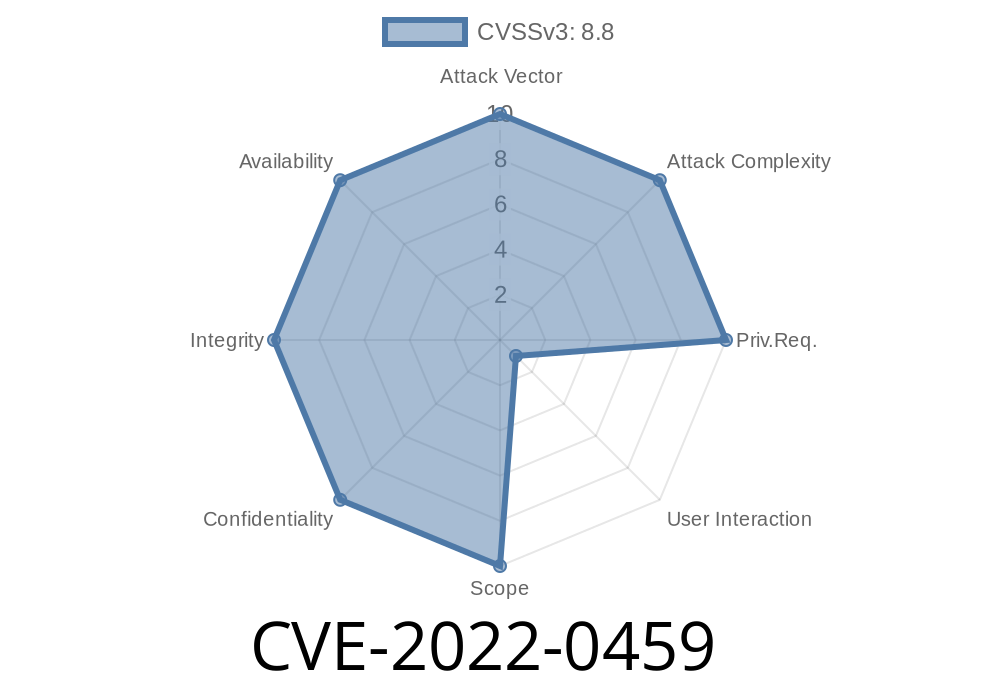Google Chrome is among the most commonly used web browsers, making it a popular target for attackers. One of the recently discovered vulnerabilities in Google Chrome, CVE-2022-0459, involves use-after-free bugs in the screen capture feature. In this article, we will provide you with an in-depth understanding of this vulnerability, its exploitation, and code snippets associated with it. We will also guide you in finding and referring to original documentation.
CVE-2022-0459 Details
A use-after-free vulnerability is a type of memory corruption bug that occurs when an application uses a pointer to reference memory after it has been freed or deleted. In this case, the vulnerability exists specifically within the screen capture functionality of Google Chrome.
This bug is present in versions of Google Chrome prior to 98..4758.80 and can be exploited by an attacker who has already compromised the renderer process, which is responsible for displaying web pages. The attacker also needs to convince the user to engage in specific user interactions. Once these conditions are met, the attacker can create a malicious HTML page that triggers heap corruption, which may potentially lead to code execution or further exploitation.
Code Snippet
Here is a simple example of an HTML page that incorporates the API call to getUserMedia() to access the screen capture functionality in Google Chrome. This is not an actual exploit but a demonstration of the vulnerable feature:
<!DOCTYPE html>
<html>
<head>
<title>Screen Capture Demo</title>
<script>
async function startCapture() {
try {
const displayMediaOptions = {
video: {
cursor: "always"
},
audio: false
};
const stream = await navigator.mediaDevices.getDisplayMedia(displayMediaOptions);
const videoElement = document.getElementById("video");
videoElement.srcObject = stream;
} catch (err) {
console.error("Error: " + err);
}
}
</script>
</head>
<body>
<h1>Screen Capture Demo</h1>
<button onclick="startCapture()">Start Screen Capture</button>
<video id="video" autoplay></video>
</body>
</html>
Original References
To get a better understanding of CVE-2022-0459, you can refer to the following original source material:
1. Google Chrome Releases Blog: https://chromereleases.googleblog.com/2022/02/stable-channel-update-for-desktop.html
2. CVE Details Page: https://nvd.nist.gov/vuln/detail/CVE-2022-0459
3. Chromium Bug Tracker: https://bugs.chromium.org/p/chromium/issues/detail?id=1289923
4. Mitre CVE Details: https://cve.mitre.org/cgi-bin/cvename.cgi?name=CVE-2022-0459
Exploit Details
Exploiting this vulnerability is not trivial and requires a deep understanding of Google Chrome internals, as well as specialized knowledge pertaining to browser exploitation techniques. In addition, as previously mentioned, the attacker must already have compromised the renderer process.
While there is no public exploit code available for this vulnerability at the moment, skilled attackers could create one after studying the vulnerable code and understanding the exploitation process. Due to the complexity and specialized knowledge required for exploiting this vulnerability, it is primarily a concern for targeted attacks.
Conclusion
CVE-2022-0459 is a critical vulnerability in Google Chrome that can potentially be exploited by remote attackers who have compromised the renderer process and convinced the user to engage in specific interactions. Understanding the details about this vulnerability will help you make more informed decisions about updating and securing your version of Google Chrome.
Make sure to update your Google Chrome to version 98..4758.80 or later to mitigate the risks associated with CVE-2022-0459.
Timeline
Published on: 04/05/2022 01:15:00 UTC
Last modified on: 04/11/2022 09:38:00 UTC
